Aces High Air Manuals
Volume 1: Attack Aircraft
AC-119 Shadow
AC-130 Spectre, Spooky
The gunship's sole user is the United States Air Force, which uses AC-130H Spectre, AC-130U Spooky, AC-130J Ghostrider, and AC-130W Stinger II variants for close air support, air interdiction and force protection. Close air support roles include supporting ground troops, escorting convoys, and flying urban operations. Air interdiction missions are conducted against planned targets and targets of opportunity. Force protection missions include defending air bases and other facilities. AC-130s deploy to bases worldwide in support of operations.
All of the weaponry aboard is mounted to fire from the left (port) side of the non-pressurised aircraft. During an attack the gunship performs a pylon turn, flying in a large circle around the target, allowing it to fire at it far longer than a conventional attack aircraft. The AC-130H Spectre was armed with two 20 mm M61 Vulcan cannons, one Bofors 40mm autocannon, and one 105 mm M102 cannon, although on most missions after 1994 the 20 mm cannons were removed due to their incompatibility with precision targeting and to carry more 40 mm and 105 mm ammunition. Another reason the 20 mm cannons were removed was due to insufficient slant range to target to operate outside of the shoulder launched missile threat envelope.
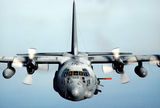
|
AC-130A Spectre Flight Manual
428 pages
|

|
AC-130H Spectre Operations
26 pages
|
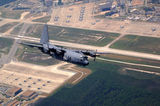
|
AC-130U Spooky Operations
29 pages
The upgraded AC-130U Spooky has a single 25 mm GAU-12 Equalizer in place of the Spectre's twin
20 mm cannons, an improved fire control system, and increased ammunition capacity.
|
F-117 Nighthawk
The F-117 was widely publicized for its role in the Persian Gulf War of 1991. It was commonly referred to as the "Stealth Fighter", although it was a strictly ground-attack aircraft. The F-117 also saw combat in Yugoslavia, during which the only aircraft of the type to be lost in combat was shot down by a surface-to-air battery on 27 March 1999. The Air Force retired the F-117 on 22 April 2008, primarily because of the fielding of the F-22 Raptor and the impending introduction of the multirole F-35 Lightning II.
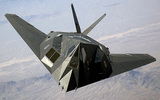
|
F-117 Nighthawk Utility Flight Manual OCIP Supplement
87 pages
This supplement to the Flight Manual pertains to specific aircraft modified under the Offensive Combat Improvement Program (OCIP).
|

|
F-117 Nighthawk Aircrew Training
65 pages
|
AV-8B Harrier II
Typically operated from small aircraft carriers, large amphibious assault ships and simple forward operating bases, AV-8Bs have participated in numerous military and humanitarian operations, proving themselves versatile assets. U.S. Army General Norman Schwarzkopf named the USMC Harrier II as one of the seven most important weapons of the Gulf War. The aircraft took part in combat during the Iraq War beginning in 2003. The Harrier II has served in Operation Enduring Freedom in Afghanistan since 2001, and was used in Operation Odyssey Dawn in Libya in 2011. Italian and Spanish Harrier IIs have taken part in overseas conflicts in conjunction with NATO coalitions. During its service history, the AV-8B has had a high accident rate, related to the percentage of time spent in critical take-off and landing phases. USMC and Italian Navy AV-8Bs are to be replaced by the Lockheed Martin F-35B Lightning II, with the former expected to operate its Harriers until at least 2030.
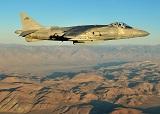
|
AV-8 Harrier II Tactical Manual Volume I
800 pages
|

|
AV-8 Harrier II Tactical Manual Volume II
1043 pages
|
Grumman OV-1 Mohawk
Although the OV-1 was retired in 1996 and few airworthy survivors remain, in 2011 Alliant Techsystems partnered with the Broadbay Group and Mohawk Technologies of Florida in a venture to return an armed, modernized version of the OV-1D to operational use as a counter-insurgency aircraft. A demonstrator was equipped with a FLIR Star Safire turret and a ventral, trainable M230 chain gun.

|
Grumman OV-1D Mohawk Operator's Manual
544 pages
|

|
Grumman OV-1 Mohawk Maneuver Guide
38 pages
|
North American Rockwell OV-10 Bronco
The Bronco performed observation, forward air control, helicopter escort, armed reconnaissance, utility light air transport and limited ground attack. The Bronco has also performed aerial radiological reconnaissance, tactical air observation, artillery and naval gunfire spotting, airborne control of tactical air support operations and front line, low-level aerial photography.
Cessna A-37 Dragonfly
The growing American military involvement in Vietnam in the early 1960s led to strong interest in counter-insurgency (COIN) aircraft. In August 1967, 25 A-37As were sent to Vietnam under the "Combat Dragon" evaluation program, and flew from Bien Hoa Air Base on USAF "air commando" missions, including close air support, helicopter escort, FAC, and night interdiction.
During this period, the A-37As flew thousands of sorties. None were lost to enemy fire, although two were wrecked in landing accidents. The A-37A was formally named the "Dragonfly", but most pilots called it the "Super Tweet". The Combat Dragon program was successful, but unsurprisingly the combat evaluation revealed some of the deficiencies of the A-37A. The most noticeable problem was that the aircraft lacked range and endurance. Other concerns were heavy control response during attack runs (the flight controls were not power-boosted) and the vulnerability of the aircraft's non-redundant flight control system.
The USAF signed a contract with Cessna in early 1967 for an improved Super Tweet, designated the "A-37B". The initial order was for 57 aircraft, but this was quickly increased to 127. The A-37Bs were primarily intended to be supplied to the Republic of Vietnam Air Force (VNAF) as replacements for their Skyraiders. The A-37B prototype was rolled out in September 1967, with deliveries to the South Vietnamese beginning in 1968.
The A-37Bs were all newly built airframes. These were stronger than those of the A-37A, capable of pulling 6 g instead of 5, and were built to have a longer fatigue life of 4,000 hours. Field experience would demonstrate that 7,000 hours between overhauls could be tolerated.
In all, 577 A-37s in all variants were built, with 254 delivered to the Republic of Vietnam Air Force. At war's end, the A-37 had flown over 160,000 combat sorties with only 22 USAF losses. Approximately 187 A-37Bs were in South Vietnamese service when the country fell. Ninety-two were recovered by the US, while the other 95 were later used by the Communist Vietnamese in missions over Cambodia and during the China conflict in 1979. These "renegade" aircraft were phased out of service in the late 1970s or early 1980s, in all probability due to lack of spares.
After the war, the USAF passed their A-37Bs from the USAF Tactical Air Command (TAC) to TAC-gained units in the Air National Guard and Air Force Reserve. In the early 1980s these aircraft were assigned to the FAC (Forward Air Control) role and given the designation OA-37B. The OA-37Bs were eventually phased out in the 1980s and 1990s and replaced in the FAC mission by the much more formidable Fairchild Republic A-10 Thunderbolt II in Air Force, Air National Guard and Air Force Reserve service.



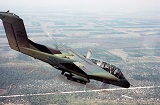

The A-10 was designed around the GAU-8 Avenger, a 30 mm rotary cannon that is the airplane's primary armament and the heaviest such automatic cannon mounted on an aircraft. The A-10's airframe was designed for survivability, with measures such as 1,200 pounds of titanium armor for protection of the cockpit and aircraft systems that enables the aircraft to continue flying after taking significant damage. The A-10A single-seat variant was the only version built, though one A-10A was converted to the A-10B twin-seat version. In 2005, a program was begun to upgrade A-10A aircraft to the A-10C configuration.
The A-10's official name comes from the Republic P-47 Thunderbolt of World War II, a fighter that was particularly effective at close air support. The A-10 is more commonly known by its nicknames Warthog or Hog. It also has a secondary mission, where it provides airborne forward air control, directing other aircraft in attacks on ground targets. Aircraft used primarily in this role are designated OA-10. With a variety of upgrades and wing replacements, the A-10's service life may be extended to 2028. However, there are proposals to retire it sooner.